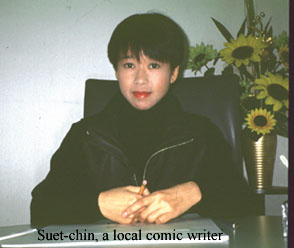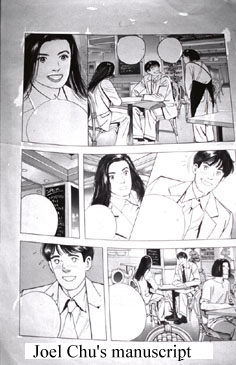The future of comics depends on the efforts of local writers
By Wylie Yeo
In a comic workshop in Tsing Yi, Suet-chin, whose real name is Jas- mine Chan Sin-mei, was working hard on her latest comic, Sunshine Has Melted His Waxy Wings. As she did when producing her famous comic First Love, Second Chance, Suet-chin had to draw hurriedly overnight.
She said, “Many Japanese comic writers, such as Akira Toriyama, the writer of Dragon Ball, work and live in their workshops.” She herself also practices this.
Suet-chin sometimes needs to work for more than 10 hours nonstop. The long and irregular working hours leave her with little time to spend with parents and friends.
“Sometimes, I cannot see my dad and mum for a whole month, and I seldom meet my friends,” said she. “Once I do get out to meet my friends, I take every minute to talk.”
 Suet-chin regards her isolation as an obstacle to her career, since close contact with people could inspire her work.
Suet-chin regards her isolation as an obstacle to her career, since close contact with people could inspire her work.
Mr. Joel Chu, 32, a creative director of an advertising company, is also a part-time comic writer. He was a principal writer in Jade Dynasty when he was 19. He published his first single-story comic book, I Don’t Want to Live Alone, in October last year.
“One of the biggest problems local comic writers encounter is their ignorance about what is happening around them,” said Mr. Chu. “They spend 10 or more hours on drawing every day.”
“Instead, a comic author should experience life and write their comics with their own point of view,” he added.
His last comic was based on a Japanese TV drama which was broadcast locally by Star TV. Although the effort to produce the book was too large compared to the profit, Mr. Chu and his friends were glad to succeed in publishing a book and establishing a workshop on their own.
Said Mr. Chu: “Having a complete plot helped me to tell the story more precisely and clearly.”
To tell a story, there should be a narrative part to build up the main story stream, and of course the personalities of the characters.
Suet-chin experienced the disadvantage of not having a complete narration when she was working on the comic First Love, Second Chance at Ming Pao.
“I was only able to get the story when I started to do the presentation,” Suet-chin said.
“I had to collect part of the story at 4 o’clock in the morning day by day to finish it on time. This situation lasted for about half a year.
“The outcome was not satisfactory. The story was badly done since I could not find enough background information.
“I had so little communication with the narrator that I was not able to draw some facial expressions in extreme cases,” she added.
Mr. David Ki Man-kit, general manger of Jade Dynasty, agreed that comic authors should understand exactly what they really want to tell their readers.
“Comic authors are advised to use other authors’ stories, but the presentation should be of their own,” Mr. Ki said.
 “I always tell the newcomers to create their own style in story telling in order to succeed.
“I always tell the newcomers to create their own style in story telling in order to succeed.
“A comic author will not improve himself if he keeps on imitating other people. Japanese comics should only be used as a reference when freshmen begin to learn drawing comics,” he added.
“The strength that many famous Japanese authors possess -- the technique of telling a story -- was absent in local ones,” said Mr. Chu.
“However, this is the most essential element of a story.”
“It is meaningless to overemphasize the importance of the so-called Hong Kong style and resist any form of change,” said Mr. Chu. “Newcomers tend to imitate Japanese comics, but they should gradually build up their own style. This is the way how they learn to tell a story in comics.”
Mr. Ki thought that in recent years, there have been no newcomers that could be potential successors to the existing well-known local comic authors.
“Newcomers commonly do not work hard enough,” Mr. Ki said.
“They tend to measure their accomplishments in terms of how much money they can earn.”
To remedy the shortage of talented comic authors, Mr. Chu thought that large comic companies should shoulder the responsibility by “providing formal training for newcomers.”
“Those companies could invite some foreign comic authors to give a few lectures to freshmen,” he added.
“This seems to be difficult to achieve, but it is worthwhile since their experience are invaluable.”
“Readers often criticise traditional local comics for seemingly missing boxes between two successive pictures. Readers are therefore unable to get the meaning of a story,” said Mr. Chu.
Mr. Chu suggested that companies should “run scientific research to determine what kind of content readers prefer.”
Mr. Ki thinks that in the future the Hong Kong market will be part of the huge Chinese comic market. He predicted that after the transition of authority in 1997, the Chinese government would not exert much control over Hong Kong comic publications since it will recognise the importance of comics with Chinese characters.
On the other hand, the copyrights of the majority of Japanese publications are valid until 30 June 1997. Local publication companies would become vulnerable if they completely rely on the revenue from the sales of those Japanese comics. Developing high quality local comics is the only way out.
“One of the reasons why I established this workshop is to prove that my goals of creating comics are right,” said Mr. Chu.

October 1996
